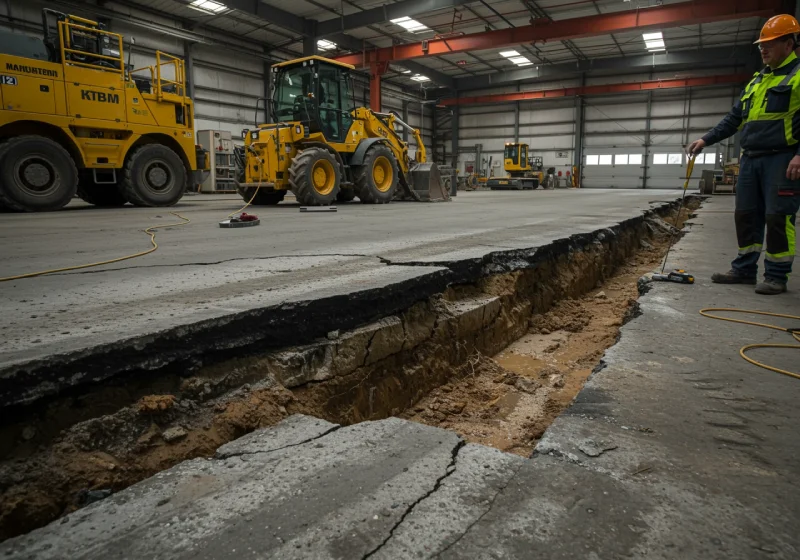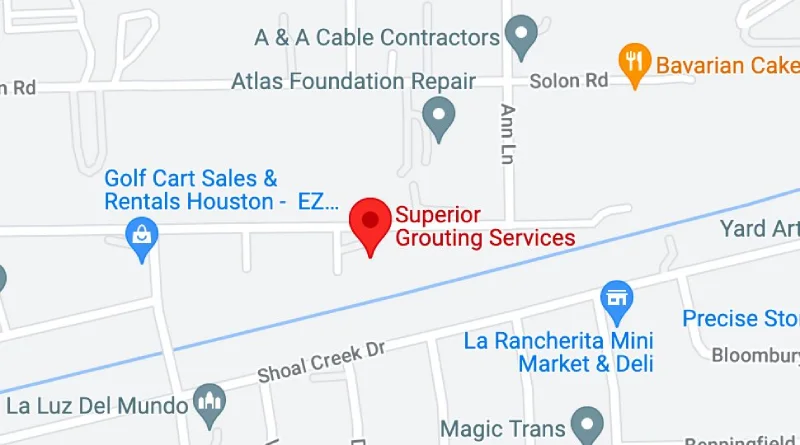Causes of Sinking Concrete Slabs in Industrial Facilities

Sinking concrete slabs in industrial facilities result from soil erosion beneath the foundation, water intrusion that weakens the soil base, poor compaction during construction, and excessive structural loading that creates voids and unstable conditions under the concrete surface.
Industrial concrete slabs endure tremendous stress from heavy machinery, high inventory loads, and constant operational demands. When these slabs begin to sink, they create immediate safety hazards, disrupt daily operations, and lead to expensive structural damage throughout the facility. Understanding the root causes of concrete sinking helps facility managers and owners prevent problems before they start and address issues quickly when they arise. Superior Grouting specializes in concrete leveling solutions that restore slab stability, eliminate safety risks, and extend the operational life of industrial facilities across Texas and beyond.
Key Takeaways
- Differential settlement happens when soil beneath the slab settles unevenly due to varying soil properties or uneven load distribution, causing cracks and structural instability that worsens over time without intervention.
- Broken pipes, rainwater runoff, and high water tables introduce moisture beneath slabs that saturates soil, reduces its load-bearing capacity, and washes away supporting material, leading to gradual sinking and void formation.
- Inadequate soil compaction during initial construction leaves air pockets and loose soil that compress under the slab's weight, while poor site preparation and insufficient reinforcement create weak points where sinking begins.
- Heavy machinery traffic, improper material handling practices like pushing loaded pallets, and concentrated point loads from storage racks exceed design specifications and accelerate concrete damage and soil compression beneath high-traffic areas.
- Comprehensive soil testing before construction, proper site preparation with verified compaction, effective drainage systems, strategic load distribution planning, and regular inspection programs prevent most sinking problems.
- Mudjacking pumps cementitious grout to lift slabs cost-effectively with longer cure times, while polyurethane foam injection offers rapid curing and minimal downtime, with method selection depending on budget, timeline, and soil conditions.
What Causes Industrial Concrete Slabs to Sink?
Industrial concrete slab sinking stems from a combination of soil conditions, environmental factors, construction quality, and operational stresses. These causes often interact and compound each other, making early detection and intervention critical to preventing extensive damage.
Soil-Related Causes
The soil beneath your concrete slab serves as the foundation for everything above it. When this soil fails to provide adequate support, sinking becomes inevitable.
Different soil types behave differently under industrial operations:
- Clay soils expand when wet and shrink when dry, creating constant movement
- Sandy soils compress easily without proper compaction
- Organic soils decompose over time and lose volume
- Each soil type requires specific construction approaches
Differential settlement occurs when different parts of a slab sink at different rates, creating uneven surfaces. Industrial sites rarely have uniform soil conditions throughout the entire building footprint. One section might sit on dense clay while another rests on looser sandy soil, causing different settlement rates.
Water Intrusion Problems
Water represents one of the most destructive forces affecting concrete slab stability. When water reaches the soil beneath a slab, it changes the soil's properties and weakens its ability to support weight.
Common sources of water intrusion include:
- Leaking underground pipes creating constant water flow that erodes soil
- Rainwater seeping through joints and cracks to reach the soil base
- Poor drainage systems allowing water accumulation around foundations
- High water tables keeping soil constantly saturated
A small leak from a water line can flow thousands of gallons over weeks and months. This water saturates the surrounding soil, reduces its strength, and begins washing away soil particles. Many facility managers remain unaware of underground leaks until significant soil erosion causes visible slab damage.
Surface water problems often worsen during heavy rains when drainage systems become overwhelmed. Clogged gutters overflow and dump water directly at building foundations. Broken downspouts discharge water at the building base instead of carrying it away. Poor site grading slopes toward buildings instead of away from them.
Construction and Design Deficiencies
How a facility was originally constructed determines whether slabs will remain stable or develop sinking problems. Cutting corners during construction creates weaknesses that manifest as sinking once the facility enters full operation.
Critical construction quality factors:
- Complete removal of organic material that decomposes over time
- Proper soil compaction in layers with verified density testing
- Adequate reinforcement design for expected operational loads
- Proper site grading for drainage
Poor compaction leaves voids and loose soil that compress under the slab's weight once construction finishes and operations begin. The compaction process requires specialized equipment, proper moisture content in the soil, and compaction in layers rather than all at once.
Concrete reinforcement distributes loads, controls cracking, and maintains slab integrity under stress. Industrial facilities need robust reinforcement because they face heavier loads than residential buildings. When reinforcement design proves inadequate, slabs crack more easily and develop conditions that lead to sinking.
Operational Factors That Accelerate Sinking
Daily operations in industrial facilities subject concrete slabs to stresses that accelerate sinking when combined with underlying soil and construction issues.
Heavy Machinery Traffic
Forklifts, pallet jacks, and material handling equipment create repeated impact loads every time they travel across the floor. While individual impacts cause minimal damage, thousands of repetitions day after day accumulate into significant wear and structural damage.
High-traffic lanes develop more cracks because they experience far more loading cycles:
- Constant vibration from passing equipment works cracks wider over time
- Impact forces from equipment crossing joints create stress concentrations
- Areas where equipment turns or stops experience more severe stresses
- Loaded equipment stresses floors much more than empty equipment
Improper Material Handling
How employees operate equipment and handle materials significantly impacts concrete floor life. Common damaging practices include:
- Pushing loaded pallets across floors instead of lifting them
- Dropping heavy items from excessive heights
- Operating forklifts at excessive speeds
- Making sharp turns at high speeds
These operational choices seem minor individually but their cumulative effect over years causes substantial damage. Facilities that train operators in floor-friendly practices extend slab life significantly.
Excessive Point Loading
Industrial storage and equipment often concentrate tremendous weight in small areas, creating point loads that exceed design specifications:
- Storage racks with narrow footpads concentrate weight into small areas
- Heavy equipment on small leveling pads creates similar point loading
- Stacking materials without adequate load spreading creates excessive pressure
When point loads exceed the slab's design capacity, the concrete cracks and the soil compresses locally. This compression creates depressions that grow over time.
Prevention Strategies
Preventing sinking costs far less than repairing it after problems develop. Comprehensive prevention strategies address soil conditions, water management, design quality, and operational practices.
Comprehensive Soil Testing
Soil testing before construction reveals conditions that will affect long-term slab stability. Proper testing identifies:
- Soil type and bearing capacity
- Moisture content and drainage characteristics
- Compaction requirements for stable foundations
- Weak layers that need removal or reinforcement
Testing should occur across the entire building footprint at multiple depths. The investment in thorough soil testing is minimal compared to the cost of repairing sinking slabs caused by unanticipated soil problems.
Proper Site Preparation and Compaction
Site preparation quality determines foundation stability. Essential steps include:
- Removing all organic material, soft soil, and unsuitable materials
- Replacing removed material with engineered fill
- Compacting in layers with verified density testing
- Proper grading for drainage away from the building
Compaction verification through field testing ensures the work meets specifications. Accepting site preparation without verified testing risks building on inadequately compacted soil that will settle later.
Effective Drainage Systems
Keeping water away from slab foundations prevents most water-related sinking problems. Critical drainage components include:
- Perimeter drains that intercept groundwater and surface water
- Gutters and downspouts that handle roof runoff properly
- Site grading that slopes away from buildings
- Regular maintenance to keep systems functioning
Gutters need regular cleaning to prevent overflow. Perimeter drains require periodic inspection and cleaning to remove sediment. Drainage maintenance represents one of the most cost-effective preventive measures available.
Regular Inspection Programs
Systematic inspection catches sinking problems early when repairs are simpler and less expensive. Early warning signs include:
- Small cracks appearing or existing cracks growing wider
- Slight elevation changes creating uneven surfaces
- Gaps developing between slabs and walls
- Water pooling in areas that previously drained properly
Inspection frequency depends on facility age, operational intensity, and known risk factors. New facilities might need only annual inspections initially. High-traffic industrial operations benefit from quarterly inspections.
Modern Repair Solutions
When prevention fails and slabs sink, modern repair methods lift and stabilize concrete without complete replacement. These methods minimize operational disruption and cost far less than replacement.
Mudjacking Process
Mudjacking lifts sunken concrete by pumping a cementitious grout mixture through drilled holes to fill voids and raise the concrete. The process involves:
- Drilling 1.5 to 2-inch holes through the slab at strategic locations
- Pumping grout beneath the slab to fill voids from bottom up
- Monitoring elevation changes to achieve precise leveling
- Plugging holes with cement to match surrounding concrete
Mudjacking advantages:
- Costs 30-50% less than slab replacement
- Uses environmentally friendly materials
- Can lift large areas during single mobilizations
- Provides permanent support once fully cured
Limitations to consider:
- Requires several days cure time before full load capacity
- Larger drill holes are more visible
- Works less effectively in very wet conditions
- Large voids may require excessive grout volumes
Polyurethane Foam Leveling
Polyurethane foam injection uses a two-component expanding foam that hardens quickly after mixing. The process requires:
- Drilling smaller holes (5/8 inch) compared to mudjacking
- Injecting foam components that react and expand beneath the slab
- Monitoring lift carefully as foam continues expanding briefly after injection
- Rapid curing in 15 minutes to an hour depending on formulation
Polyurethane foam advantages:
- Rapid cure minimizes downtime, allowing operations within hours
- Lightweight foam adds minimal weight to compromised soil
- Resists water absorption and erosion excellently
- Small injection holes are less visible
- Closed-cell structure prevents water penetration
Considerations include:
- Higher material cost than mudjacking
- Requires specialized equipment and experienced technicians
- Uncontrolled expansion can over-lift slabs if not properly managed
- Works best for moderate void depths
Choosing the Right Method
Selecting the optimal repair method depends on multiple factors:
| Factor | Mudjacking | Polyurethane Foam |
| Cost | Lower material cost | Higher material cost |
| Cure Time | 3-7 days | 15-60 minutes |
| Downtime | Extended closure required | Minimal operational disruption |
| Wet Conditions | Less effective | Excellent performance |
| Hole Size | 1.5-2 inches | 5/8 inch |
| Best For | Budget-conscious, dry conditions | Time-sensitive, wet conditions |
Facilities with flexibility in scheduling may prefer mudjacking's lower cost. Operations that cannot afford extended downtime often choose polyurethane foam because rapid return to service justifies the investment.
Both methods successfully lift and stabilize slabs when applied correctly. The key to success lies not just in method selection but in addressing underlying causes. Lifting the slab without fixing drainage problems, repairing soil erosion sources, or reducing excessive loads creates only temporary improvement.
Conclusion
Industrial concrete slab sinking results from complex interactions between soil conditions, water intrusion, construction quality, and operational stresses. Understanding the causes empowers facility managers to implement effective prevention strategies and make informed repair decisions.
Prevention through comprehensive soil testing, proper construction practices, effective drainage, and appropriate design stops most sinking problems before they start. Regular inspection catches developing issues early when interventions remain simple and inexpensive. Modern repair methods including mudjacking and polyurethane foam leveling provide cost-effective alternatives to complete replacement.If your facility experiences sinking concrete, cracks, uneven surfaces, or other foundation problems, professional evaluation and repair restore stability and prevent additional damage. Contact Superior Grouting to discuss your concrete leveling needs and learn how modern repair methods can solve your foundation problems.

